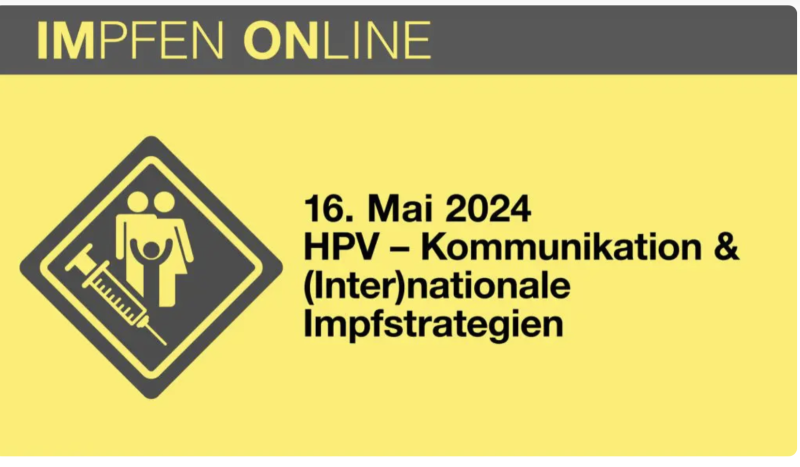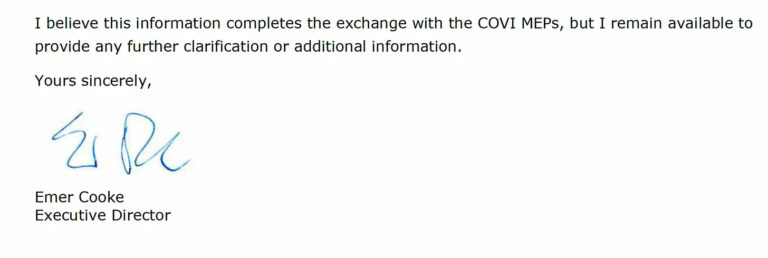HPV vaccination – the combination of pharmaceutical business and medicine
Source: TKP.at, Dr. Peter F. Mayer, 232 May 2024
The HPV vaccination is one that has been fraught with problems and controversy from the start. Given the side effects and questionable usefulness, especially for boys and men, it obviously takes some sales skills to get them to women or men. That’s why it’s obviously necessary to train doctors in the right sales pitch.
If doctors listen to these events, they will receive “up to 4 DFP points on your account” if they provide their membership number in the medical association, as noted on the lecture page on medconnect . Information about the diploma advanced training program of the Austrian Medical Association (ÖÄK) can be found here . The entire event was sponsored by MSD, the manufacturer of the HPV vaccine, and the MSD logo remains visible throughout. The Austrian Vaccination Academy (ÖIA) and the Austrian Society for Pediatric and Adolescent Medicine (ÖGKJ) are apparently the organizers.
The first speaker, Kenneth A. Alexander, glosses over his declaration of conflicts of interest, but at least states them in writing:

It is strange that a lecture by a speaker paid by Merck and Moderna is part of the medical association’s further training. But it gets even worse.

Regarding this slide, Alexander explains that you should limit yourself to these three points: no education, no scientific studies and, above all: never tempt vaccination customers to ask questions!

Short sales training on how to catch customers, praise them and steer them in the right direction.
 If necessary, name the child to be vaccinated and repeat the previous three points.
If necessary, name the child to be vaccinated and repeat the previous three points.
Legally, however, the situation is such that every medical treatment constitutes bodily harm, which only goes unpunished if there is complete information that enables “informed consent”. I know of cases of court judgments for damages and compensation for pain and suffering against doctors who only incompletely fulfilled this obligation.
However, Alexander recommends not informing or educating at all, but rather working with short, affirmative announcements. This excerpt from the lecture with a transcript can be heard in Appendix 1 below.
Next was the lecture by Dr. Katja Fischer, who is a member of the National Vaccination Committee and is apparently responsible for the HPV vaccination in the vaccination department of the Ministry of Health. One would now expect that, as a public official, she would point out the legal and ethical requirements regarding informed consent. But no, she first wants to underline the message that the previous speaker gave.
She is proud that Austria was among the first countries to introduce a second vaccination and now also a third injection for older ones. The entire lecture can also be found in Appendix 2 below.
The third speaker is Prof. Elmar Joura from MedUniVienna. He is also proud of the first HPV vaccination in Austria in 2006 and of having been a pioneer in the constant expansion of the number of syringes.
There is no separate slide about conflicts of interest, but he briefly states: “ I conducted vaccination studies for MSD.”
His statement about HPV testing in men is interesting.

He says: “ We strongly advise against testing men because men have a high HPV prevalence of 30 to 50 percent and we have no algorithm on how to deal with HPV-positive men.”
Apparently they want to avoid vaccinated people wondering why they had a vaccination that couldn’t prevent an infection. However, that is the question, since there is no apparent benefit in men, but side effects are possible.
Does the HPV vaccination protect or harm
HPV is passenger virus, a virus that comes and goes. That’s why Joura strongly advises against testing, because it won’t be good if the virus is detected in vaccinated people. But that doesn’t seem to matter anyway.
It always revolves around the same business concept: creating fear using a surrogate marker and then twisting the statistics and studies as if the surrogate marker said something and as if the (expensive) intervention would do something. The tricks used are always the same.
Even in the Gardasil patient information, the effectiveness is formulated extremely carefully:
“GARDASIL is a vaccine (injection/syringe) used as an adjuvant to protect against the following diseases caused by human papillomavirus (HPV) types (6, 11, 16 and 18)”
However, the potentiator aluminum is always a risk and, although rare, leads to serious side effects.
New studies continue to emerge, such as this one from February 16, 2024: Anti-NMDA Receptor Encephalitis, Human Papillomavirus, and microRNA. This research suggests that the HPV vaccine may trigger a rare autoimmune brain disease that causes psychiatric or neurological symptoms after vaccination – and can easily be confused with psychosis in its early stages. There were also reports about this in the Austrian press in 2007:
According to the speakers at this event, information about possible negative side effects should be avoided.
Second girl in intensive care after vaccination
OÖ Nachrichten 2008: One death and seven illnesses
OÖ Nachrichten: 15-year-old in intensive care after cancer vaccination
A documentary film written and narrated by Joan Shenton and directed by Andi Reiss shows how young girls are being severely harmed by the vaccine with the most reported side effects of any vaccine in existence: https://www.sacrificialvirgins.org/
Cervical cancer has declined dramatically in recent decades. Why is not so clear. Possibly fewer cigarettes among women. But the decline is clear and significant. In Sweden, the incidence of cervical cancer has also fallen massively in recent years , before the introduction of the HPV vaccination.
Cervical cancer occurs mainly in older age and is usually diagnosed in women over 50. That’s why there’s no point in doing a study like Joura’s, where women between the ages of 17 and 30 are examined. The question arises as to what bias comes into play when, as in this study, only women well before the typical age group are examined? This can be read about in Kristina Hellman’s “ The mean age at diagnosis for adenocarcinoma and squamous cell carcinoma ” .
Even the authors of the study on the 2nd slide by Joura only admit that the HPV vaccination reduces the risk of cervical cancer by half (without addressing the problems and biases mentioned): “ The cumulative incidence among unvaccinated women rose sharply to 94 cases per 100,000 persons by 30 years of age, whereas the cumulative incidence among vaccinated women was 47 cases per 100,000 persons by 30 years of age.
This is a more than weak result and speaks against the HPV vaccination. The authors of this study report on another analysis from Finland where the puzzle is solved: with the HPV vaccination, HPV is significantly suppressed, but this has no effect on the frequency of cervical cancer because it is only “associated” and not causally determined. The logical consequence is little to no HPV-associated cervical cancer, but only HPV-free cervical cancer. But this is not reported because the studies only deal with HPV-associated cervical cancer.
Annex 1
05:44: It’s really just a few steps. It is not so hard. We emphasize that HPV vaccination is part of routine practice. We normalize the process.
And with normalization we’re trying to convince people that this is just like giving a baby an MMR shot. We usually vaccinate teenagers. This is routine. Secondly, we emphasize that it is about cancer prevention. We don’t need to talk about sexuality or teenagers.
We talk about the fact that you and I are in cancer prevention, and then we encourage parents to do it today. And therein lie the three ingredients for a successful announcement. Let me give you an example. Mom Emma will soon be twelve years old. And at the age of twelve, we routinely have all of our boys vaccinated.
And we will protect girls against HPV cancer. We’re giving Emma her vaccine today. And then we stop. And this is where doctors get into trouble because they tend to say too much. They say things like, “Mom, is there something you have a question about?”
But no. Research shows that when we make this three-step announcement, about 60 to 75 percent of American parents, and I assume it’s the same with Austrian parents, say in ten to 15 seconds: Okay, you’re successful. And I know as a pediatrician, I know as a general practitioner, how much there is to do in your practice, but you don’t need to get into a big discussion here. Emma is twelve years old today. At the age of twelve, we routinely give all of our boys and girls a vaccine to prevent cancer.
We should get Emma vaccinated today. Done, 10 seconds. And research shows that this works very, very well. That’s why we remind people once again that the HPV vaccination is routine. It’s about cancer prevention and we’re going to do it today.
Now for 60 to 70% of people. Done and done.” 8:10
Appendix 2
(By the way, it may be that these rather revealing videos will soon be set to “private” and will therefore no longer be visible.
Lecture by Kenneth A. Alexander, MD:
Lecture Dr. Katja Fischer, member of the National Vaccination Committee and apparently responsible for HPV vaccination in the Ministry of Health:
The lecturer is Prof. Elmar Joura from MedUniVienna
More about HPV
Merck again sued over damage caused by HPV vaccine Gardasil
The vaccination bus is running again: EU vaccination week for HPV, measles and multiple preparations
Study: HPV injection is linked to four autoimmune diseases
HPV vaccination “safe and effective”? Parallels to Covid, HIV/AIDS
Even more HPV injections at tax costs – new green vaccination campaign
“Under the Skin” – The “banned” film about the HPV vaccination
Suggest a correction







